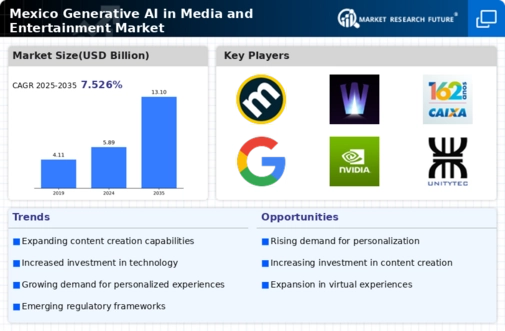The generative ai-in-media-and-entertainment market is currently characterized by a dynamic competitive landscape, driven by rapid technological advancements and increasing demand for innovative content creation solutions. Key players such as OpenAI (US), Google (US), and Adobe (US) are at the forefront, each adopting distinct strategies to enhance their market positioning. OpenAI (US) focuses on developing cutting-edge AI models that facilitate creative processes, while Google (US) leverages its extensive data resources to refine its generative capabilities. Adobe (US), on the other hand, emphasizes integration of AI tools within its existing software suite, thereby enhancing user experience and operational efficiency. Collectively, these strategies contribute to a competitive environment that is increasingly centered around innovation and technological integration.
In terms of business tactics, companies are increasingly localizing their operations to better cater to regional markets, optimizing supply chains to enhance efficiency, and investing in partnerships that bolster their technological capabilities. The market structure appears moderately fragmented, with a mix of established players and emerging startups vying for market share. This fragmentation allows for diverse offerings, yet the influence of major players remains substantial, shaping industry standards and consumer expectations.
In October 2025, OpenAI (US) announced a partnership with a leading Mexican media company to develop localized AI content generation tools tailored for the Latin American market. This strategic move is likely to enhance OpenAI's presence in the region, allowing it to tap into local cultural nuances and preferences, thereby increasing user engagement and satisfaction. Such collaborations may also facilitate knowledge transfer and innovation, positioning OpenAI as a key player in the regional landscape.
In September 2025, Google (US) unveiled a new generative AI feature within its cloud services aimed at media companies, enabling them to automate content creation processes. This initiative not only strengthens Google's foothold in the media sector but also reflects a broader trend towards automation and efficiency in content production. By providing tools that streamline workflows, Google is likely to attract a diverse clientele, enhancing its competitive edge.
In August 2025, Adobe (US) launched an AI-driven tool designed to assist filmmakers in post-production, significantly reducing editing time. This innovation underscores Adobe's commitment to integrating AI into its product offerings, thereby enhancing the creative capabilities of its users. The strategic importance of this launch lies in its potential to redefine industry standards for efficiency and creativity, positioning Adobe as a leader in the generative AI space.
As of November 2025, the competitive trends within the generative ai-in-media-and-entertainment market are increasingly defined by digitalization, sustainability, and the integration of AI technologies. Strategic alliances are becoming pivotal, as companies seek to combine strengths and resources to innovate more effectively. Looking ahead, competitive differentiation is expected to evolve, shifting from traditional price-based competition to a focus on innovation, technological advancement, and supply chain reliability. This transition may redefine how companies engage with consumers, emphasizing the importance of unique offerings and enhanced user experiences.
























Leave a Comment